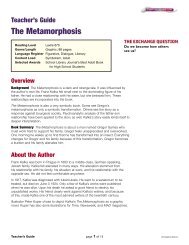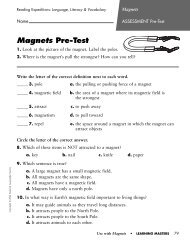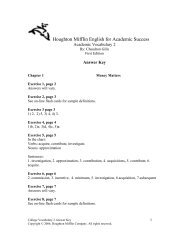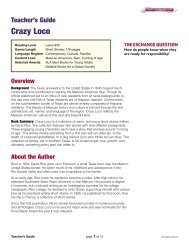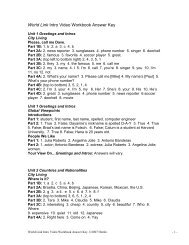English for Cabin Crew Trainer's Guide - Heinle
English for Cabin Crew Trainer's Guide - Heinle
English for Cabin Crew Trainer's Guide - Heinle
Create successful ePaper yourself
Turn your PDF publications into a flip-book with our unique Google optimized e-Paper software.
UNIT<br />
9 Case study<br />
LEAD IN Speaking<br />
Write on the board: Toilet troubles <strong>for</strong> Cathay. Ask students if<br />
they can guess what the text will be about. Ask, Have you ever<br />
experienced problems with toilets? What happened? What did you<br />
do about it?<br />
EXERCISE 1 Reading<br />
Give students time to read the questions. Then ask them to read the text<br />
and make notes. Let students discuss the answers in pairs be<strong>for</strong>e getting<br />
feedback in open class.<br />
Answers<br />
1 All of the ten toilets on board became blocked soon after take-off.<br />
2 The plane had to make an unscheduled landing in Mumbai.<br />
Vocabulary in context<br />
Write the following words on the board and ask students to match them<br />
to synonyms in the text: can’t be moved (blocked); clear (obvious);<br />
uncontrolled (chaos); stopped to an extent (restricted).<br />
EXERCISE 2 Speaking<br />
The aim here is to get students talking about their personal experiences.<br />
Give students time to read through the questions and think of responses.<br />
Ask them to discuss their responses in pairs or small groups. After a few<br />
minutes, get one student from each pair or group to briefl y summarize<br />
the main points of their discussion.<br />
Pre-teaching vocabulary<br />
Check the following key words: engage with passengers (talk to them);<br />
gauge passengers (work out what sort of person they are); get to know<br />
passengers (meet and become friends with them); appease passengers<br />
(say things to calm them down when they are angry).<br />
EXERCISE 3 and 4 Listening<br />
Give students time to read the situation and questions in exercise 3. Play<br />
the recording. Students listen, take notes and then discuss their answers<br />
in pairs. Get feedback in open class at the end.<br />
Follow the same procedure <strong>for</strong> exercise 4.<br />
Answers<br />
1 to be collected: meal trays, drinks, headsets, blankets (rubbish also<br />
has to be collected, or ‘cleared in’); to be checked: landing cards,<br />
seatbelts; to be handed out: immigration <strong>for</strong>ms (then also to be<br />
checked); to be secured: the cabin, the galley; to be stowed: trolleys<br />
2 She hadn’t been given a landing card and there was only ten minutes<br />
be<strong>for</strong>e landing. Shon’s crew had not advised her of this; there was a<br />
breakdown in communication. The woman should have been given the<br />
<strong>for</strong>ms well in advance of landing.<br />
3 pilot/co-pilot and passengers: minimal communication, usually<br />
about the time of arrival, the weather, any delays, thanking passengers<br />
<strong>for</strong> travelling with the airline<br />
passengers and cabin crew: a lot of communication about preparing<br />
the passengers <strong>for</strong> landing (having headsets ready <strong>for</strong> collection,<br />
fi lling out landing cards and immigration <strong>for</strong>ms, arrival procedures,<br />
returning to seats and fastening seatbelts, etc.)<br />
fl ight crew and cabin crew: very minimal communication apart from<br />
advising that passengers and galley are ready <strong>for</strong> landing and the<br />
cabin is secure<br />
CD2 Track 9.8<br />
1 Is preparing <strong>for</strong> landing easier than preparing <strong>for</strong> take-off?<br />
S: Preparing <strong>for</strong> landing is more stressful actually than preparing <strong>for</strong> take-off<br />
because with take-off you’ve got just the welcoming of passengers, the safety<br />
checks and the preparation, but coming in <strong>for</strong> landing you’ve got the human<br />
factor. You’ve got people sitting on board, you’ve got drinks and debris that<br />
you’ve provided – well you haven’t provided the passengers with debris but<br />
the meal trays, the drinks – all of that is still possibly out in the cabin, you’ve<br />
got headsets that need to be collected, blankets that need to be collected,<br />
landing cards that have to be checked, immigration <strong>for</strong>ms that have to<br />
be handed out and checked to make sure that passengers have completed<br />
them correctly. On top of that you’ve got your checking of seatbelts and the<br />
securing of the cabin and the galley, so coming in <strong>for</strong> landing is actually quite<br />
stressful because there’s a lot going on during those fi nal sort of ten, fi fteen<br />
minutes. You’re stowing trolleys, you’re securing the galley, you’re going into<br />
the cabin, clearing in any rubbish. Also answering questions because people<br />
are near their arrival so they want to now check with you that their fl ight is<br />
on time or their connection is going to be there. They might want to ask you<br />
questions about where do they pick their baggage up, and you’re doing all of<br />
this while you are completing all the other pre-landing duties, so yes, landing<br />
duties tend to be a lot more stressful than those <strong>for</strong> take-off.<br />
2 Do you remember any special problems with passengers in the fi nal ten minutes?<br />
S: I don’t remember any particular problems with passengers during that fi nal<br />
ten minutes of landing, but occasionally, if I can recall one, I remember this<br />
<strong>for</strong>eign lady. She had not completed any of the <strong>for</strong>ms and the crew hadn’t<br />
alerted me to this fact and as I was going through the cabin, checking<br />
seatbelts and checking tables were stowed, etcetera, the neighbour sitting<br />
next to this passenger actually just said to me, you know, this lady hasn’t got<br />
a landing card and it was a bit of a panic because as the senior in charge of<br />
the fl ight it’s my job to coordinate the landing so that all my crew are doing<br />
what they should be doing and the cabin is secure, and suddenly I’d got this<br />
lady that nobody had told me about, who didn’t speak a word of <strong>English</strong>, and<br />
we were arriving in ten minutes and I had no history about her, so that was a<br />
bit of a panic.<br />
3 Can you briefl y outline communications in the fi nal phases of descent?<br />
S: The fi nal phases of descent when the aircraft is preparing to land.<br />
Sometimes there’s minimal communication between the pilot and the<br />
passenger. It largely depends on what’s going on. I mean they may come<br />
on to the inter-phone and just thank the passengers <strong>for</strong> travelling with<br />
them. They may tell them of weather conditions that they’re expecting and<br />
of course they will tell the passengers of the local time. Also in that last<br />
ten minutes of fl ight the captain or co-pilot may just advise passengers of<br />
any holding. You know, if the fl ight is being delayed <strong>for</strong> any reason, but<br />
generally it’s, fairly, it’s kept to the minimum in terms of communication.<br />
The captain will have made his announcement a good twenty minutes<br />
prior to landing. That’s on long-haul fl ights. Obviously short-haul fl ights<br />
it’s slightly different and the cockpit do tend to communicate with the<br />
passengers a little closer to landing so they may hear something. Between<br />
the passengers and the cabin crew there’s usually a lot of communication<br />
going on, particularly on long-haul fl ights where various crew members<br />
may be in<strong>for</strong>ming the passengers of the need to have headsets ready <strong>for</strong><br />
collection. There’ll be another announcement usually made about landing<br />
cards and immigration <strong>for</strong>ms and then there’s often communication from<br />
the senior crew member who will be advising the passengers of arrival<br />
procedures and there’s yet other announcements preparing the passengers<br />
<strong>for</strong> landing such as please return to your seats and you need to fasten your<br />
seatbelts now, so there’s quite a lot of communication going on between<br />
passengers and cabin crew. Not so much between fl ight crew and passengers<br />
and very minimal communication really between fl ight crew and cabin<br />
crew other than the need <strong>for</strong> the cabin crew to in<strong>for</strong>m the fl ight crew that<br />
passengers and galleys are all ready <strong>for</strong> landing, and it’s usually kept to the<br />
minimum, usually just simple sentences such as captain, cabin now secure,<br />
or aircraft now secure.<br />
41



